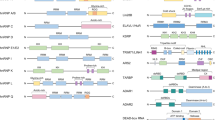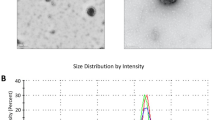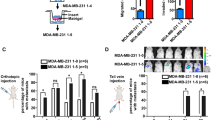Abstract
The long non-coding RNA, HOTTIP, has an important role in tumorigenesis. It is known that HOTTIP regulates HOX gene family; however, its regulatory mechanism in esophageal squamous cell carcinoma (ESCC) remains elusive. In this study, we investigated the role of HOTTIP in ESCC and observed that HOTTIP/HOXA13 was upregulated in ESCC and promoted cell proliferation and metastasis in vivo and in vitro. Interestingly, harboring a miR-30b-binding site, HOTTIP as a molecular sponge mainly regulated miR-30b level in the nucleus and modulated the repression of HOXA13 mediated by miR-30b in the cytoplasm, resulting in the positive HOTTIP/HOXA13 correlation. In addition, HOTTIP upregulated snail1 by competitively binding miR-30b, subsequently promoting epithelial–mesenchymal transition (EMT) and invasion. HOTTIP directly bound the adaptor protein WDR5 and drove histone H3 lysine 4 trimethylation and HOXA13 gene transcription in ESCC cells. In conclusion, our findings indicated that HOTTIP modulated HOXA13 at both the transcriptional and posttranscriptional levels in ESCC cells and HOTTIP–miR-30b–HOXA13 axis may serve as potential diagnostic markers or drug targets for ESCC therapies.
This is a preview of subscription content, access via your institution
Access options
Subscribe to this journal
Receive 50 print issues and online access
$259.00 per year
only $5.18 per issue
Buy this article
- Purchase on Springer Link
- Instant access to full article PDF
Prices may be subject to local taxes which are calculated during checkout








Similar content being viewed by others
Abbreviations
- ESCC:
-
esophageal squamous cell carcinoma
- lncRNA:
-
long non-coding RNA
- EMT:
-
epithelial–mesenchymal transition.
References
Xu Y, Yu X, Chen Q, Mao W . Neoadjuvant versus adjuvant treatment: which one is better for resectable esophageal squamous cell carcinoma? World J Surg Oncol 2012; 10: 173.
Deng HP, Chen L, Fan T, Zhang B, Xu Y, Geng Q . Finishing the euchromatic sequence of the human genome. Nature 2004; 431: 931–945.
Deng HP, Chen L, Fan T, Zhang B, Xu Y, Geng Q . Long non-coding RNA HOTTIP promotes tumor growth and inhibits cell apoptosis in lung cancer. Cell Mol Biol 2015; 61: 34–40.
Li W, Kang Y . A new LncRNA in metastasis: long noncoding RNA mediates the prometastatic functions of TGF-β. Cancer Cell 2014; 25: 557–559.
Zhou X, Ye F, Yin C, Zhuang Y, Yue G, Zhang G . The Interaction between miR-141 and lncRNA-H19 in regulating cell proliferation and migration in gastric cancer. Cell Physiol Biochem 2015; 36: 1440–1452.
Lu Z, Pannunzio NR, Greisman HA, Casero D, Parekh C, Lieber MR . Convergent BCL6 and lncRNA promoters demarcate the major breakpoint region for BCL6 translocations. Blood 2015; 126: 1730–1731.
Wu Y, Huang C, Meng X, Li J . Long noncoding RNA MALAT1: insights into its biogenesis and implications in human Disease. Curr Pharm Des 2015; 21: 5017–5028.
Hajjari M, Salavaty A . HOTAIR: an oncogenic long non-coding RNA in different cancers. Cancer Biol Med 2015; 12: 1–9.
Wang GY, Zhu YY, Zhang YQ . The functional role of long non-coding RNA in digestive system carcinomas. Bull Cancer 2014; 101: E27–E31.
Jin K, Luo G, Xiao Z, Liu Z, Liu C, Ji S et al. Noncoding RNAs as potential biomarkers to predict the outcome in pancreatic cancer. Drug Des Devel Ther 2015; 9: 1247–1255.
George J, Patel T . Noncoding RNA as therapeutic targets for hepatocellular carcinoma. Semin Liver Dis 2015; 35: 63–74.
Chen FJ, Sun M, Li SQ, Wu QQ, Ji L, Liu ZL et al. Upregulation of the long non-coding RNA HOTAIR promotes esophageal squamous cell carcinoma metastasis and poor prognosis. Mol Carcinog 2013; 52: 908–915.
Pan F, Yao J, Chen Y, Zhou C, Geng P, Mao H et al. A novel long non-coding RNA FOXCUT and mRNA FOXC1 pair promote progression and predict poor prognosis in esophageal squamous cell carcinoma. Int J Clin Exp Pathol 2014; 7: 2838–2849.
Li W, Zheng J, Deng J, You Y, Wu H, Li N et al. Increased levels of the long intergenic non-protein coding RNA POU3F3 promote DNA methylation in esophageal squamous cell carcinoma cells. Gastroenterology 2014; 146: 1714–1726.e5.
Wang KC, Yang YW, Liu B, Sanyal A, Corces-Zimmerman R, Chen Y et al. A long noncoding RNA maintains active chromatin to coordinate homeotic gene expression. Nature 2011; 472: 120–124.
Garcia-Fernandez J . The genesis and evolution of homeobox gene clusters. Nat Rev Genet 2005; 6: 881–892.
Mohamadkhani A . Long noncoding RNAs in interaction with RNA binding proteins in hepatocellular carcinoma. Hepat Mon 2014; 14: e18794.
Guo B, Che T, Shi B, Guo L, Yin Y, Li L et al. Screening and identification of specific markers for bladder transitional cell carcinoma from urine urothelial cells with suppressive subtractive hybridization and cDNA microarray. Can Urol Assoc J 2011; 5: E129–E137.
Gu ZD, Shen LY, Wang H, Chen XM, Li Y, Ning T et al. HOXA13 promotes cancer cell growth and predicts poor survival of patients with esophageal squamous cell carcinoma. Cancer Res 2009; 69: 4969–4973.
Quagliata L, Matter MS, Piscuoglio S, Arabi L, Ruiz C, Procino A et al. Long noncoding RNA HOTTIP/HOXA13 expression is associated with disease progression and predicts outcome in hepatocellular carcinoma patients. Hepatology 2014; 59: 911–923.
Zhang H, Zhao L, Wang YX, Xi M, Liu SL, Luo LL . Long non-coding RNA HOTTIP is correlated with progression and prognosis in tongue squamous cell carcinoma. Tumour Biol 2015; 36: 8805–8809.
Li Z, Zhao X, Zhou Y, Liu Y, Zhou Q, Ye H et al. The long non-coding RNA HOTTIP promotes progression and gemcitabine resistance by regulating HOXA13 in pancreatic cancer. J Transl Med 2015; 13: 84.
Cheng CW, Wang HW, Chang CW, Chu HW, Chen CY, Yu JC et al. MicroRNA-30a inhibits cell migration and invasion by downregulating vimentin expression and is a potential prognostic marker in breast cancer. Breast Cancer Res Treat 2012; 134: 1081–1093.
Yao J, Liang L, Huang S, Ding J, Tan N, Zhao Y et al. MicroRNA-30d promotes tumor invasion and metastasis by targeting Galphai2 in hepatocellular carcinoma. Hepatology 2010; 51: 846–856.
Zhong K, Chen K, Han L, Li B . MicroRNA-30b/c inhibits non-small cell lung cancer cell proliferation by targeting Rab18. BMC Cancer 2014; 14: 703.
Gagnon KT, Li L, Chu Y, Janowski BA, Corey DR . RNAi factors are present and active in human cell nuclei. Cell Rep 2014; 6: 211–221.
Wei Y, Li L, Wang D, Zhang CY, Zen K . Importin 8 regulates the transport of mature microRNAs into the cell nucleus. J Biol Chem 2014; 289: 10270–10275.
Yu H, Lin X, Wang F, Zhang B, Wang W, Shi H et al. Proliferation inhibition and the underlying molecular mechanisms of microRNA-30d in renal carcinoma cells. Oncol Lett 2014; 7: 799–804.
Sugihara H, Ishimoto T, Watanabe M, Sawayama H, Iwatsuki M, Baba Y et al. Identification of miR-30e* regulation of Bmi1 expression mediated by tumor-associated macrophages in gastrointestinal cancer. PLoS One 2013; 8: e81839.
Gaziel-Sovran A, Segura MF, Di Micco R, Collins MK, Hanniford D, Vega-Saenz de Miera E et al. miR-30b/30d regulation of GalNAc transferases enhances invasion and immunosuppression during metastasis. Cancer Cell 2011; 20: 104–118.
Huang J, Yao X, Zhang J, Dong B, Chen Q, Xue W et al. Hypoxia-induced downregulation of miR-30c promotes epithelial-mesenchymal transition in human renal cell carcinoma. Cancer Sci 2013; 104: 1609–1617.
Kwak SY, Kim BY, Ahn HJ, Yoo JO, Kim J, Bae IH et al. Ionizing radiation-inducible miR-30e promotes glioma cell invasion through EGFR stabilization by directly targeting CBL-B. FEBS J 2015; 282: 1512–1525.
Kao CJ, Martiniez A, Shi XB, Yang J, Evans CP, Dobi A et al. miR-30 as a tumor suppressor connects EGF/Src signal to ERG and EMT. Oncogene 2014; 33: 2495–2503.
Sun X, Zhao S, Li H, Chang H, Huang Z, Ding Z et al. MicroRNA-30b suppresses epithelial-mesenchymal transition and metastasis of hepatoma Cells. J Cell Physiol 2017; 232: 625–634.
Xie H, Zhu D, Xu C, Zhu H, Chen P, Li H et al. Long none coding RNA HOTTIP/HOXA13 act as synergistic role by decreasing cell migration and proliferation in Hirschsprung disease. Biochem Biophys Res Commun 2015; 463: 569–574.
Cheng Y, Jutooru I, Chadalapaka G, Corton JC, Safe S . The long non-coding RNA HOTTIP enhances pancreatic cancer cell proliferation, survival and migration. Oncotarget 2015; 6: 10840–10852.
Feng T, Shao F, Wu Q, Zhang X, Xu D, Qian K et al. miR-124 downregulation leads to breast cancer progression via LncRNA-MALAT1 regulation and CDK4/E2F1 signal activation. Oncotarget 2016; 7: 16205–16216.
Liu Z, Dou C, Yao B, Xu M, Ding L, Wang Y et al. Ftx non coding RNA-derived miR-545 promotes cell proliferation by targeting RIG-I in hepatocellular carcinoma. Oncotarget 2016; 7: 25350–25365.
Zhong Z, Xia Y, Wang P, Liu B, Chen Y . Low expression of microRNA-30c promotes invasion by inducing epithelial mesenchymal transition in non-small cell lung cancer. Mol Med Rep 2014; 10: 2575–2579.
Ye Z, Zhao L, Li J, Chen W, Li X . miR-30d blocked transforming growth factor A1-induced epithelial-mesenchymal transition by targeting Snail in ovarian cancer cells. Int J Gynecol Cancer 2015; 25: 1574–1581.
Ge Y, Yan X, Jin Y, Yang X, Yu X, Zhou L et al. MiRNA-192 and miRNA-204 directly suppress lncRNA HOTTIP and interrupt GLS1-mediated glutaminolysis in hepatocellular carcinoma. PLoS Genet 2015; 11: e1005726.
Tsang FH, Au SL, Wei L, Fan DN, Lee JM, Wong CC et al. Long non-coding RNA HOTTIP is frequently up-regulated in hepatocellular carcinoma and is targeted by tumor suppressive miR-125b. Liver Int 2015; 35: 1597–1606.
Engreitz JM, Haines JE, Perez EM, Munson G, Chen J, Kane M et al. Local regulation of gene expression by lncRNA promoters, transcription and splicing. Nature 2016; 539: 452–455.
Acknowledgements
We are very grateful to Nanjing General Hospital for providing ESCC tissues and Professor Yifeng Zhou who provided ESCC cell lines. This work was supported by Project Program of State Key Laboratory of Natural Medicines in China (no. SKLNMBZ201403); National Science and Technology Major Projects of New Drugs in China (2012ZX09103301-004 and 2014ZX09508007); National Natural Science Foundation of China (30873073); the Priority Academic Program Development of Jiangsu Higher Education Institutions (PAPD); the Central University Basic Scientific Research Business Expenses (2016ZPY009). We thank LetPub (www.letpub.com) for its linguistic assistance during the preparation of the manuscript.
Author information
Authors and Affiliations
Corresponding authors
Ethics declarations
Competing interests
The authors declare no conflict of interest.
Additional information
Supplementary Information accompanies this paper on the Oncogene website
Supplementary information
Rights and permissions
About this article
Cite this article
Lin, C., Wang, Y., Wang, Y. et al. Transcriptional and posttranscriptional regulation of HOXA13 by lncRNA HOTTIP facilitates tumorigenesis and metastasis in esophageal squamous carcinoma cells. Oncogene 36, 5392–5406 (2017). https://doi.org/10.1038/onc.2017.133
Received:
Revised:
Accepted:
Published:
Issue Date:
DOI: https://doi.org/10.1038/onc.2017.133
This article is cited by
-
LncRNA HOTTIP impacts the proliferation and differentiation of fibroblast-like synoviocytes in ankylosing spondylitis through the microRNA-30b-3p/PGK1 axis
Journal of Orthopaedic Surgery and Research (2023)
-
Novel long noncoding RNA LINC02820 augments TNF signaling pathway to remodel cytoskeleton and potentiate metastasis in esophageal squamous cell carcinoma
Cancer Gene Therapy (2023)
-
Long non-coding RNA HOTTIP exerts an oncogenic function by regulating HOXA13 in nasopharyngeal carcinoma
Molecular Biology Reports (2023)
-
LncRNA LYPLAL1-AS1 rejuvenates human adipose-derived mesenchymal stem cell senescence via transcriptional MIRLET7B inactivation
Cell & Bioscience (2022)
-
Temporal transcriptomic changes in long non-coding RNAs and messenger RNAs involved in the host immune and metabolic response during Toxoplasma gondii lytic cycle
Parasites & Vectors (2022)



